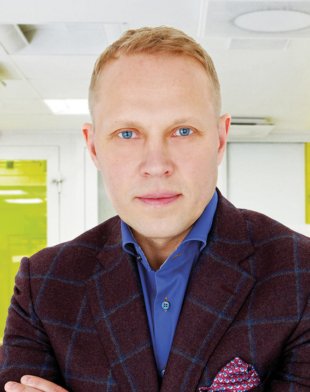Bridges: How does Inkron, the industry leader in printed optical inks, reflect the strong ties between Finland and Japan?

Rantala: Inkron is a key enabling technology provider for augmented reality (AR) device creation. Since becoming a fully owned subsidiary of Japan-based Nagase Group, we have been able to overcome major barriers to entry, and supply global tier-1 device providers of consumer and enterprise electronics.
Nagase Group has enabled Inkron to take a multidisciplinary approach to emerging AR technologies that require long-term investments in fundamental materials research, development of process technologies, testing ecosystems and human resource training.
Japan is a global leader in automotive and consumer electronics and these industry segments will require innovations in material sciences and photonics, such as instruments for autonomous driving. Finland has strong expertise in material sciences and optical engineering research and this creates excellent opportunities for Japan-Finland collaborations.
Your company PiBond develops materials that enable advanced semiconductor chip manufacturing. How important are partnerships across Asia?
PiBond has taken significant steps to become part of the critical semiconductor materials supply chain. With nanometer-scale precision required, only a handful of companies can produce semiconductor chips in their advanced form; the most advanced chips are currently produced in Taiwan and South Korea, though China is catching up. Competitive companies, and potential partnerships, primarily come from Japanese chemical conglomerates.
To improve chip performance, extreme ultraviolet lithography (EUVL) is required and requires two critical ingredients: equipment and materials. While equipment supply is limited to a few industrial giants, PiBond is one of the few independent companies which can successfully deliver inorganic EUVL materials to meet future needs.
What are your expectations for the future of the semiconductor materials industry?
The development of semiconductor materials which enable manufacturers to form chip structures at the angstrom scale (a hundred-millionth of a centimeter) is extremely challenging, and equipment, processes and molecular material control are required to ensure successful commercial implementation.
Close international collaboration between material, equipment and chip manufacturers is needed to advance chip performance. Localization close to customers is also required to guarantee detailed customization.
What new technology platforms are you driving?
I have identified attractive opportunities to utilize my deep knowledge in material sciences and photonics in new fields such as advanced medical devices and fast-diagnostic screening for precision health care segments.
I have also invested in and collaborated with Finland-based companies such as Lumoral. The company is active in antibacterial photodynamic therapy and is collaborating with medical technology companies in Japan and Asia.
How will you continue engaging with Asia-based start-ups?
Traditional larger companies often employ long-term business plans and can lack agile operating procedures which prevent rapid pivoting to new business models, although conglomerates in Asia and around the world are beginning to fund early-stage innovative technology companies.
A fascinating cultural and creative trend we hope to see continue is that engineers, scientists and innovators in Japan and Asia are shifting from traditional corporate culture toward entrepreneurial careers and international collaborations with Western start-ups, corporates and investors.



